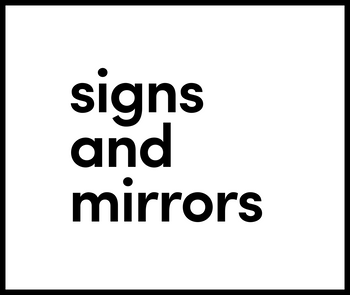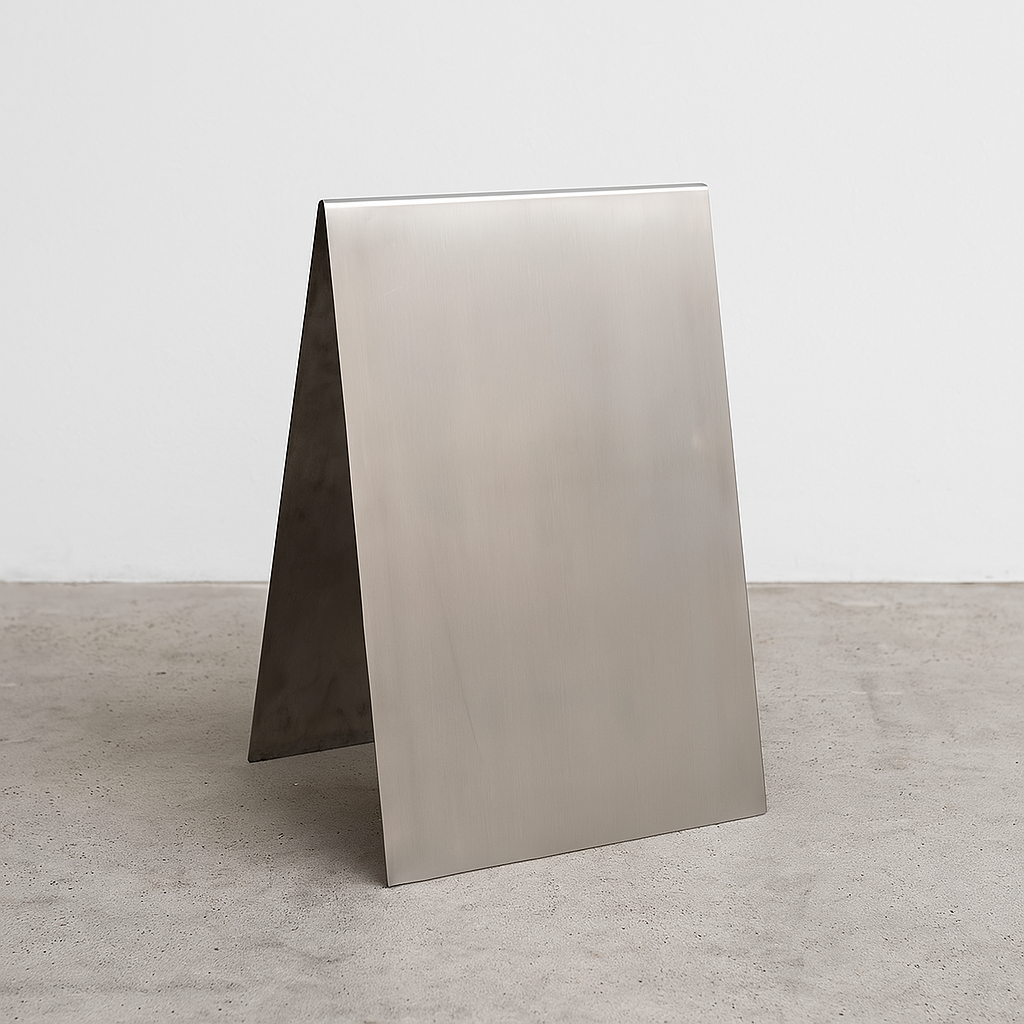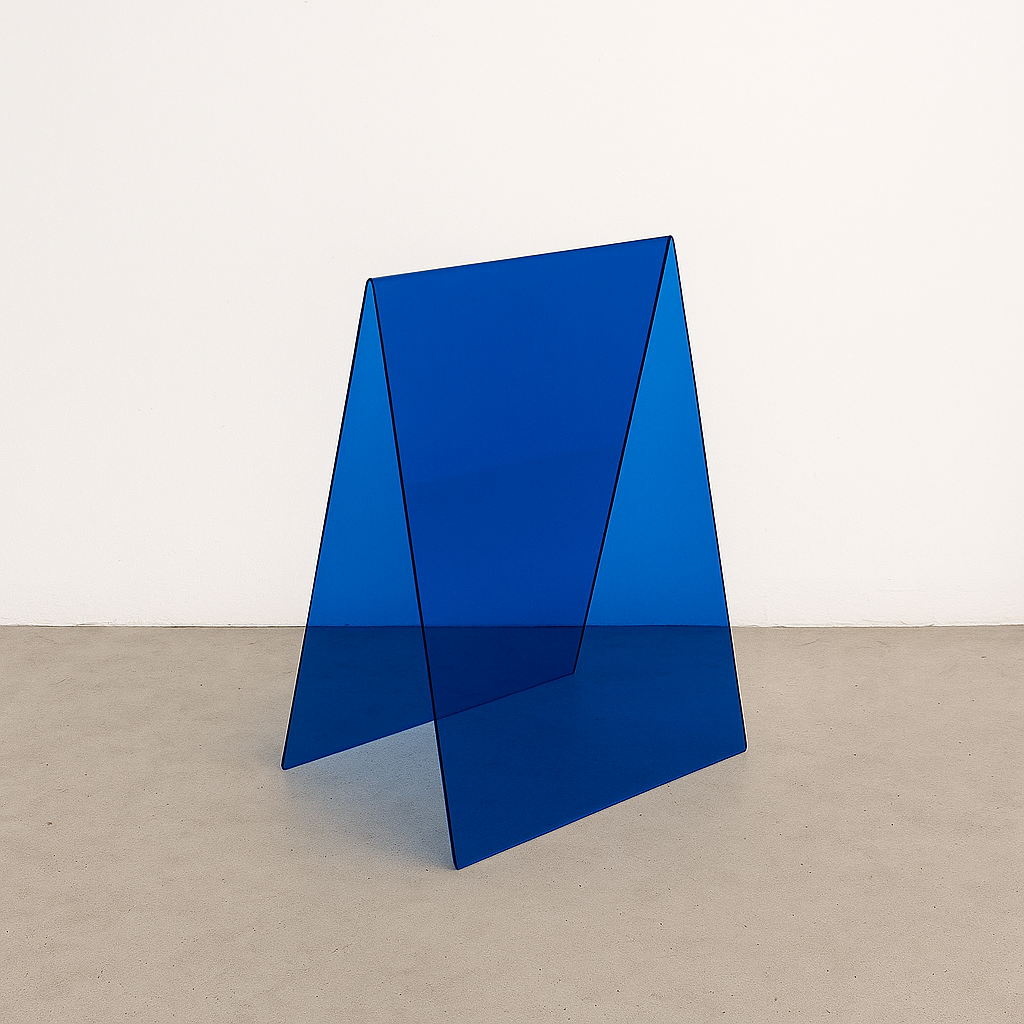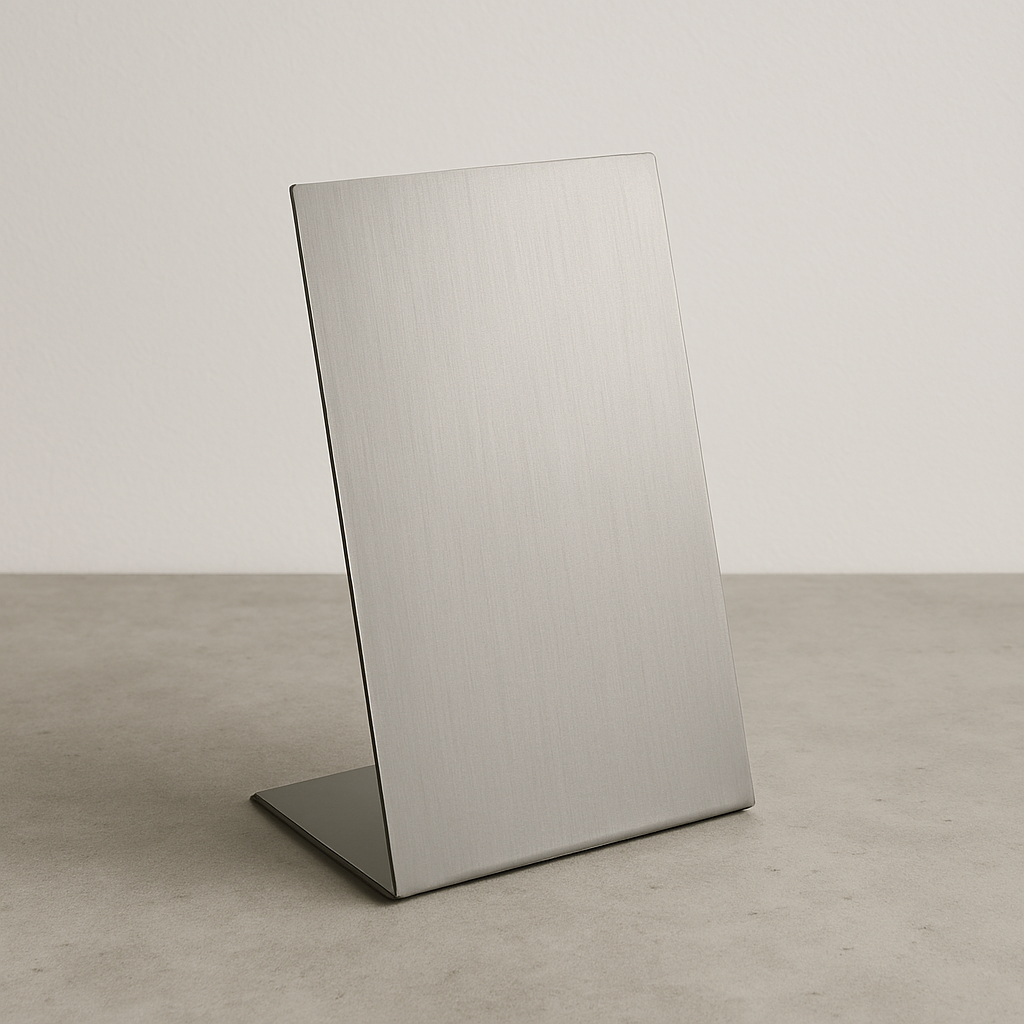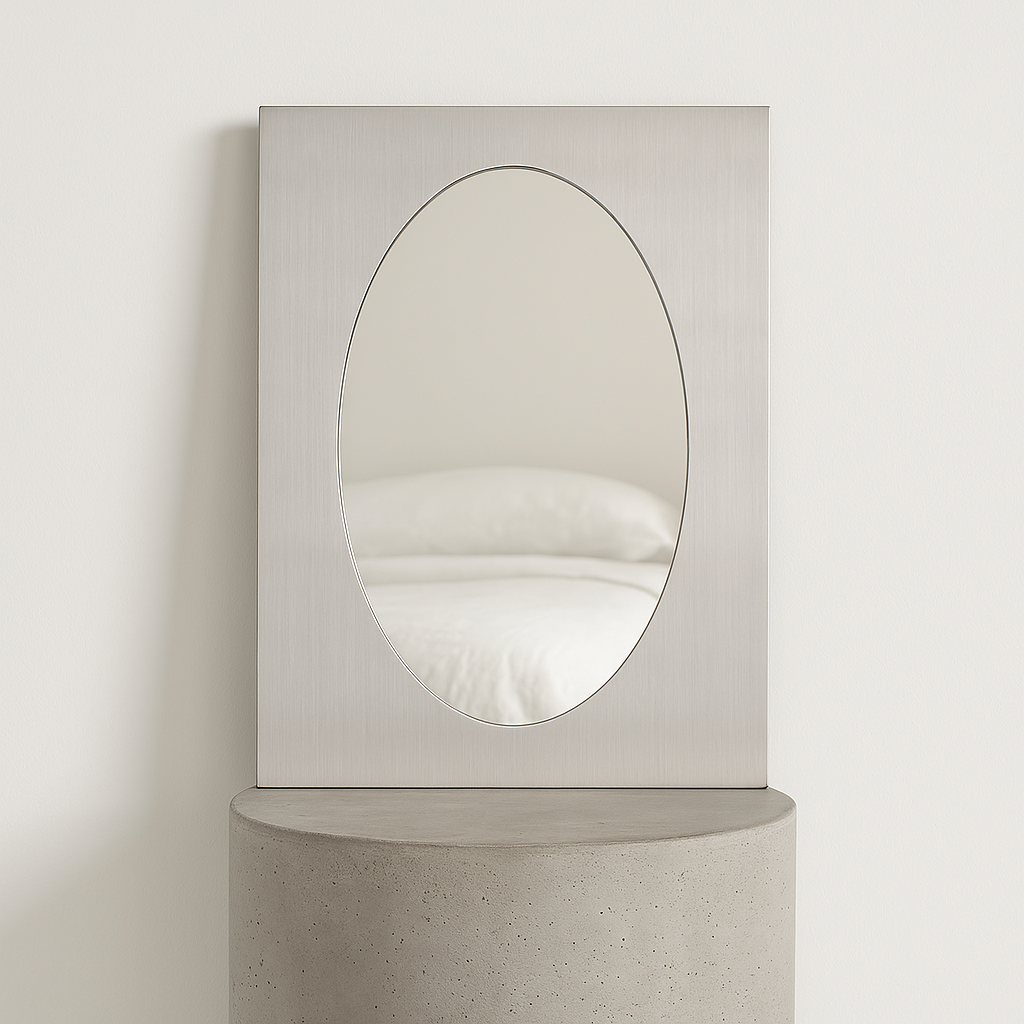Acrylic signs show up more than you might notice - leaning outside shops, tucked into museum walls, or catching light at an event check-in. They’re made from sheets of clear plastic that can be printed, shaped, or layered to create all kinds of finishes. Lighter than glass but just as sharp-looking, acrylic has quietly become one of the most adaptable materials for signage. Part durability, part simplicity, part design freedom.
What Acrylic Actually Is
Acrylic is a solid sheet of plastic - lightweight, crystal clear, and surprisingly strong. It’s sometimes called Plexiglas, Lucite, or Perspex depending on where you’re standing, but it’s all the same core material: a shatter-resistant alternative to glass that holds up well indoors and out.
It comes in different thicknesses, cuts easily, and doesn’t weigh much, which makes it ideal for signs that move around - like sidewalk boards or event displays. You can print directly onto it, laser-cut it into letters, or layer it with vinyl or ink on the back. Visually, it sits somewhere between clean and striking, depending on the finish.
Why It Works So Well for Signs
The appeal is part design, part practicality. Acrylic looks polished even when it’s doing very little - which is a nice quality for signage. It reflects light just enough to draw the eye, but not so much that it’s distracting. It stays flat, doesn’t warp, and holds color well.
It also doesn’t ask for much. A bit of care and the occasional wipe with a soft cloth is usually enough. It can be cut into precise shapes, scaled large or small, and layered in a way that gives the design depth without making it heavy. For anyone building a sign that’s meant to travel, stand up to time, or just quietly look good, acrylic tends to check every box.

Why Signs and Mirrors Keep Coming Back to Acrylic (And Probably Always Will)
At Signs and Mirrors, acrylic is one of our favorite materials to work with. It’s light, durable, and looks sharp without needing much. Most of our freestanding signs - whether mirrored, opaque, or transparent - are made with acrylic because it gives us the clean lines and finishes we like, while still being easy to move and store.
We design with utility in mind, especially for people working pop-ups, storefronts, or events. Our acrylic sidewalk sign collection includes mirrored, opaque, and transparent A-frames that fold flat, travel easily, and can be used again and again. Some clients order them blank, others send artwork for printing on both sides. Either way, the material holds up - whether it’s inside a café or sitting out on a Brooklyn sidewalk.
You can see most of our pieces in action on Instagram - out in front of coffee shops, inside studios, at brand activations, or tucked beside a checkout counter. That’s where you get the real sense of how these signs move through spaces. The material works hard, but never gets in the way. That’s why we keep using it.
Types of Acrylic Signs
Some signs sit on walls and never move. Others fold, travel, and do their job on the street. Acrylic works well in both worlds. Here’s a look at a few of the most common types - starting with three A-frames built for everyday use.
1. Transparent Acrylic A-Frame
Transparent Acrylic A-Frame is made from a single sheet of clear acrylic. The surface is glossy and smooth, and the see-through design keeps it light and minimal. Can be ordered blank or printed. Comes in different colors, but the look always stays clean and modern.
2. Opaque Acrylic A-Frame
Opaque Acrylic A-Frame uses solid-color acrylic with a high-gloss finish. Letters and designs stand out clearly, even from a distance. It’s made for sidewalk use and easy to fold, store, and reuse. Available blank or printed on both sides.
3. Mirrored Acrylic A-Frame
Mirrored Acrylic A-Frame has a reflective finish on both sides. It’s lightweight, made from acrylic with a wood backing, and folds flat when not in use. Can be ordered with or without custom print. Often used when the sign needs to stand out in photos or bright light.
4. Wall-Mounted Panels
Wall-Mounted Panels are flat acrylic sheets mounted to surfaces with screws or standoffs. They’re used for logos, wayfinding, or general info. Can be clear, frosted, or solid. Works indoors or outdoors.
5. Cut-Out Letters and Logos
Cut-Out Letters and Logos are shaped from acrylic and mounted individually. Great for names, logos, or directional icons. The pieces can sit flush or be spaced slightly off the wall for dimension.
6. Countertop and Tabletop Signs
Countertop and Tabletop Signs are small acrylic displays that sit on flat surfaces. They’re often used for menus, schedules, or small brand notes. Some stand upright, some lean back, some slot into a base. Easy to update and move around.
How Printing Changes the Look
Where you print on an acrylic sign - front or back - can shift the entire feel of the piece. Both options work, but each gives a different finish and level of durability. Here’s how to tell which one makes more sense for your setup.
Front (First Surface) Printing
The design is printed directly onto the front of the acrylic sheet. Looks more matte and sits right on the surface. It’s simple and budget-friendly, but the ink is exposed - so it can scratch more easily with handling or cleaning. Good for short-term use or signs that won’t get much contact.
Back (Second Surface) Printing
The design is printed on the back side, so it shows through the clear acrylic. This gives a glossier, glass-like finish and adds depth to the image. Because the ink is behind the surface, it’s also protected from scratches. Best for permanent signage, outdoor pieces, or anything that needs to stay looking clean longer.
Which One Should You Pick?
If you're using your sign in a space where people might touch or move it often, second surface is the safer bet. It’ll last longer and look more polished. But if you’re going for something quick, temporary, or low-touch - first surface gets the job done.
Spaces Where Acrylic Just Makes Sense
Acrylic signs tend to blend in while still doing their job - which is part of the appeal. They’re clean, lightweight, and hold up well across different spaces. Below are a few places where acrylic doesn’t just work - it works well.
- Sidewalks and storefronts: Freestanding A-frames make sense for pop-ups, cafés, or shops with rotating hours or specials. Acrylic holds print cleanly, doesn’t weigh much, and folds down when the day’s over.
- Retail and gallery walls: Wall-mounted acrylic panels or cut-out lettering keep things looking sharp without overpowering the space. Especially good when you're mixing signage with visual displays or artwork.
- Countertops and check-ins: Smaller acrylic signs do well on host stands, trade show tables, or reception desks. Easy to swap out if info changes - still neat, still readable.
- Event activations: Mirrored or color-tinted acrylic signs catch light and photograph well, which makes them useful at events, pop-ups, or anywhere people might pull out a phone.
- Offices and workspaces: Directional signs, room names, or simple logo panels in acrylic keep the tone professional without being cold. They also hold up better than paper, tape, or temporary solutions.
Keeping Your Acrylic Sign Looking Good
Acrylic is tough, but not invincible. Treat it with a bit of care and it’ll stay clean and sharp-looking for a long time. Here’s what to know.
Cleaning It Right
Acrylic attracts dust and fingerprints, especially on mirrored or glossy finishes. The surface can scratch if wiped with the wrong cloth or cleaner.
- Use a soft microfiber cloth
- Warm water with a little mild, non-abrasive soap works best; avoid ammonia-based or solvent-based cleaners to prevent clouding or crazing
- No paper towels, no rough sponges
- Skip anything with ammonia or harsh chemicals
A quick gentle wipe goes a long way. If you're working with mirrored acrylic, dry it right after to avoid water spots.
Storing It Safely
When it’s not in use, acrylic should be stored flat or upright with nothing pressing against it. No weight on top, no sharp edges nearby.
- Wrap it in a soft cloth or foam sheet
- Keep it away from heat or direct sunlight
- Don’t stack signs directly on top of each other
Even though it’s durable, pressure or heat can cause bending over time - especially with thinner pieces.
Using It Outdoors
High-quality cast acrylic with UV-resistant coating can handle outdoor use in mild conditions, but it’s not ideal for strong winds or prolonged direct sunlight, which can cause yellowing or warping in extruded acrylic.
- Bring it inside during heavy wind
- Avoid placing it in spots with all-day direct sun
- Wipe it down if it gets wet or dusty after a storm
With a bit of attention, most acrylic signage will hold up outside just fine - but like any good piece, it benefits from being brought in when conditions get rough.
Is Acrylic Right for Your Signage Project?
If you're looking for something clean, durable, and easy to work with - acrylic usually fits the bill. It handles print well, doesn’t weigh much, and moves easily between indoor and outdoor spaces. Whether you're setting up a sidewalk sign, a pop-up, or a permanent wall display, acrylic gives you plenty of finish options without overcomplicating things.
That said, it’s not for everything. If your space gets heavy wind or constant sun, you’ll want to plan around that. But for most day-to-day uses - retail, events, wayfinding, branding - it checks the right boxes. It’s solid, it’s flexible, and it does what it needs to do without shouting.
Conclusion
Acrylic signs work because they do what good design does best: they get the message across without distracting from it. Whether you're propping one up outside your café or mounting it on a gallery wall, acrylic gives you a solid base to build from. It's clean, simple, and holds up better than it looks like it should. There are fancier materials out there - and more fragile ones too - but acrylic sits comfortably in the middle. Just enough shine, just enough strength, and never trying too hard.
FAQ
What’s the difference between acrylic and glass signage?
Acrylic looks like glass from a distance - clear, glossy, sharp - but it’s lighter, stronger, and way less stressful to move around. It won’t shatter if it tips over, which makes it better for high-traffic or portable use.
Can acrylic signs go outside?
Yes, but with some caveats. They’re fine in mild weather and even light rain, but wind and strong sun can wear them down over time. If it’s stormy or blazing hot, it’s worth bringing them in.
Is it better to print on the front or the back?
Depends on the look you’re going for. Front-printed signs are a bit more matte and straightforward. Back-printed signs shine more and last longer since the ink is protected behind the acrylic.
How do I clean an acrylic sign?
Microfiber cloth, warm water, and maybe a drop of dish soap. No paper towels, no harsh sprays. Treat it like a mirror with opinions.
Can acrylic signs be recycled?
Technically yes, but it depends on your local recycling program. Some shops may also accept offcuts or scrap if you’re doing a large run and want to be mindful about waste.
